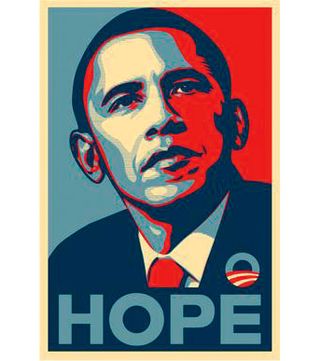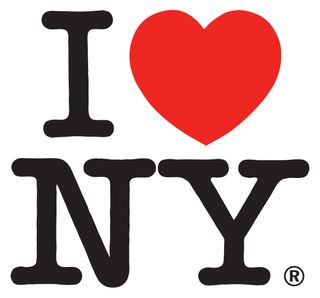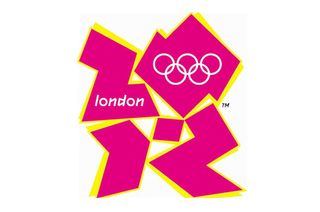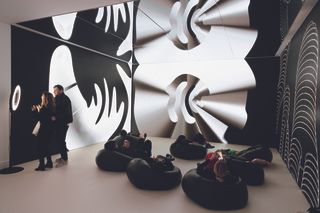15. The Obama Hope poster

Rob Janoff is best known as the designer of the original Apple logo (one of our best logos of all time). So it's fitting that the biggest influence over his work in the past 25 years is another iconic piece of design: the 'Hope' poster for Obama's 2008 presidential campaign.
"I was a huge Obama fan from the beginning," says Janoff. "I campaigned for him in several states in the Midwest where I live. And that iconic graphic poster by Shepard Fairey perfectly represented my hometown Chicago hero's message of hope. The strong Obama logo was the thing that sealed the deal for me. He was an icon representing himself with an icon. He was speaking my language."
16. Occupy
The worldwide 'Occupy' protests against capitalism in 2011 were a dramatic sign that old political models were breaking down. And they influenced many walks of life, including art and design.
"Seeing people in the Occupy movement – not all of them necessarily designers – respond to a moment visually and creatively was incredibly inspiring," recalls designer and creative director Craig Oldham. And the design world has since repaid the favour, becoming increasingly political itself.
The role of politics has changed in design, and is so much part of it now
Jonathan Barnbrook
"The role of politics has changed in design, and is so much part of it now," says graphic designer Jonathan Barnbrook, who's best known for his font designs and David Bowie album covers. "When I became interested in 'activist work' it was seen as something quite separate; it's now part of the mainstream. There's a bigger understanding that those seductive tools – which are used to sell us stuff we don't need – could also be used against the same pointless grind to endlessly consume."
17. Marketing takes over

The man who's been called the godfather of graphic design, Milton Glaser is known for everything from the I 'Heart' NY poster to the DC Comics logo, and was awarded the National Medal of the Arts award in 2009 by President Barack Obama. Now 90, he tells us, however, that his career has not been all sweetness and light.
"The key elements in my professional life that have had the most influence have been the alarming degree of control over all graphic projects by marketing and advertising companies," Milton complains. "Every idea is dominated by previous historical success, which tends always to protect profitability by creating things that are already familiar.
Get the Creative Bloq Newsletter
Daily design news, reviews, how-tos and more, as picked by the editors.
"This is not a great environment for the imagination, in search for meaning," he argues. "People in the graphic arts are thought as technicians to help achieve the already- established goals."
18. Genre blurring
Another trend has been a breaking down of boundaries between job titles. This means, happily, that creatives no longer need to be pigeonholed in one specific role, but can cross disciplines and follow their dreams at will.
"The blurring of lines between creative genres has been very freeing, creatively," says artist and designer Jeremyville. "Clients and galleries have been much more open to viewing all aspects of the artist's career as a part of the whole, with no one discipline being more important that the other. And that's made it easier for me to pursue a huge variety of approaches, whether that's illustration, painting, publishing, product design, toy design, installations, large-scale sculptures, animations, brand collaborations, or street and community initiatives."
19. Web typography

In the late 2000s, web typography rose to the fore. "Developments between 2008 and 2011 finally made web typography a plausible venture, both for type users and type makers," recalls type designer Tobias Frere-Jones. "It had been possible for several years before, but that period saw browsers adopting wider font format support, the WOFF spec and the launch of Typekit. Sophisticated web typography quickly went from an exception to an expectation."
20. Creative Bloq
In the late 2000s and early 2010s, many publications launched websites, but most simply replicated their print content online. In 2012, however, Computer Arts took a different tack. It teamed up with two sister titles: net magazine, which focused on web development, and 3D World, which covered VFX and animation, to launch a new kind of website called Creative Bloq. The idea was that, with more and more creatives working across different disciplines, one site covering all areas would prove more than the sum of its parts.
Later, ImagineFX came on board, and articles about traditional and digital art were added to the mix. Since then, Creative Bloq has become the world's biggest online art and design magazine globally, bar none.
21. Digital drawing
"The most memorable tech for me of the past 25 years was getting my first digital pen," says graphic designer, illustrator and artist Noma Bar. "Moving to Wacom from a mouse and the different gripping and hand movement involved wasn't easy. But after a while, it became an extension of the arm, liberating my lines and making everything faster."
The iPad had become a tool of creation, rather than just consumption
Daniel Stolle
Wacom's success spurred other manufacturers to enter the market, and today Lisa Maltby is a big fan of Apple's own drawing tech. "The invention of the iPad Pro and Apple Pencil has changed how I create illustrations," she says. "There are so many options of digital brushes, textures and colour that would otherwise be hard to replicate traditionally. Exploring new technology forces you to try out different things, and rethink how you draw or design.
While wary of assigning too much importance to tech, illustrator Daniel Stolle says digital tools have been a big influence on his career, too. "For me, the combined introduction of Procreate, the Apple Pencil and the iPad Pro was a critical moment," he says. "It meant the iPad had become a tool of creation, rather than just consumption."
Feeling inspired? Check out our pick of the best drawing tablets on the market right now.
22. 2012 Olympics' logo

Wolff Olins' logo for the London Olympics was something you either loved or hated, but everyone certainly had an opinion on it.
First launched in 2007, tabloid newspapers campaigned to have it changed and at Adobe Live in London in 2007, Neville Brody argued it resembled Bart Simpson receiving fellatio from Lisa. But the design also drew fans and admirers. Computer Arts gave airtime to both sides of the debate, and incredibly, it's one that reverberates to this day.
Radim Malinic, creative director at Brand Nu, selects this logo and identity, perhaps provocatively, as his stand-alone design moment of the past 25 years. "I think Wolff Olins has proven, despite the great controversy, that it's possible to deliver timeless ideas against the magnitude of the event," he says. "It reminds me that going against the grain pays off."
23. Computer Arts redesigns

By 2013, Computer Arts had reached a watershed. Its original selling point had been its tutorials, which had appealed to amateurs and pros alike. But tutorials in general were now widely available online for free. In response, the magazine slowly transformed itself into an authorative industry title, pitched squarely at professional designers and agencies.
This new content wasn't gelling right with the ageing look and structure of the magazine, though, and so a major redesign was in order. And it had to be done right, with no half-measures.
It was a radical change for a new era, and somewhat of a gamble. "We knew there'd be some backlash from more entry-level readers who enjoyed the step-by-step tutorials and cover-mounted disc. But we knew this move was necessary to open up exciting new possibilities for the brand," says then-editor Nick Carson.
And the gamble paid off. "The corresponding positive feedback at the other end of the readership – particularly agencies – was overwhelmingly positive, heralding Computer Arts as a much-needed champion for design, and applauding its real-world approach to practical content. And the following year, the successful launch of the Brand Impact Awards and the UK Studio Rankings proved that the brand could engage the industry at the very highest level."
24. Design moves outside of major cities
In the mid-nineties, British magazines were often accused of being London-centric. But in all honesty, if a UK design agency didn't have a London base back then, it probably wasn't going to be taken all that seriously.
Over the years, though, greater connectivity has meant that where you're based matters less. And nowadays some of the biggest British firms are now based outside the capital; in 2019, two even entered the top 10 of the UK Studio Rankings: Universal Everything (Sheffield) and Taxi Studio (Bristol).
Freelancers, too, have been moving out of London, New York and other big cities, and that's created a virtuous circle. "A defining moment for me was when I was still a student and discovered the wonderful typographic work of Steven Bonner," recalls graphic designer and typographer Craig Black. "I couldn't believe he was based in Scotland, yet working as an independent designer with some of the world's most exciting brands. Before then, I never knew that was possible. This was the point when I realised what I wanted for my own career, and it provided me with the focus to make that dream become a reality."
If you want to check out job opportunities across the UK, head over to our newly-refreshed design jobs board.
25. Design becomes a global language

So what's the biggest thing to happen to design over the past 25 years? Perhaps it's less a specific technology or piece of work than a fundamental reimagining of what a designer is.
Jessica Helfand, designer, educator and founding editor of Design Observer observes the changes. "Design has become a global language, and here's why that matters. To the degree that technology and automation both amplify and threaten so much of what we do, see and make, our human skills – seeing, observing, listening as the ambassadors of communication we've all been groomed to become – will become even more critical over the next 25 years."
While there's a clear trend towards homogenisation, artist and designer Kelli Anderson feels that isn't the whole story. "Right now, it feels like there's new room in design culture for weird, niche, experimental projects," she says. "For instance, as an independent designer, I can now design on my computer, prototype using a Graphtec desktop cutter, and coordinate a print/ production run of thousands of books from my home studio. Perhaps because of this increased access, we're seeing more perspectives, pushing the boundaries of what is possible.
"Playful, experimental, weird design work is championed on social media," she continues, "ranging from Zach Lieberman's code experiments to Sight Unseen's championing of new forms of furniture, and in real-life spaces, from the wide variety of experimental books and zines at the NY Art Book Fair to the design objects for sale at SSHH!. It's a very exciting time."
This article originally appeared in the 300th celebratory issue of Computer Arts, the world's best-selling design magazine. Buy issue 300, or subscribe to CA here.
Read more:

Thank you for reading 5 articles this month* Join now for unlimited access
Enjoy your first month for just £1 / $1 / €1
*Read 5 free articles per month without a subscription

Join now for unlimited access
Try first month for just £1 / $1 / €1
- 1
- 2
Current page: Landmark graphic design events: 15-25
Prev Page Landmark graphic design events: 01-14
Tom May is an award-winning journalist and editor specialising in design, photography and technology. Author of the Amazon #1 bestseller Great TED Talks: Creativity, published by Pavilion Books, Tom was previously editor of Professional Photography magazine, associate editor at Creative Bloq, and deputy editor at net magazine. Today, he is a regular contributor to Creative Bloq and its sister sites Digital Camera World, T3.com and Tech Radar. He also writes for Creative Boom and works on content marketing projects.